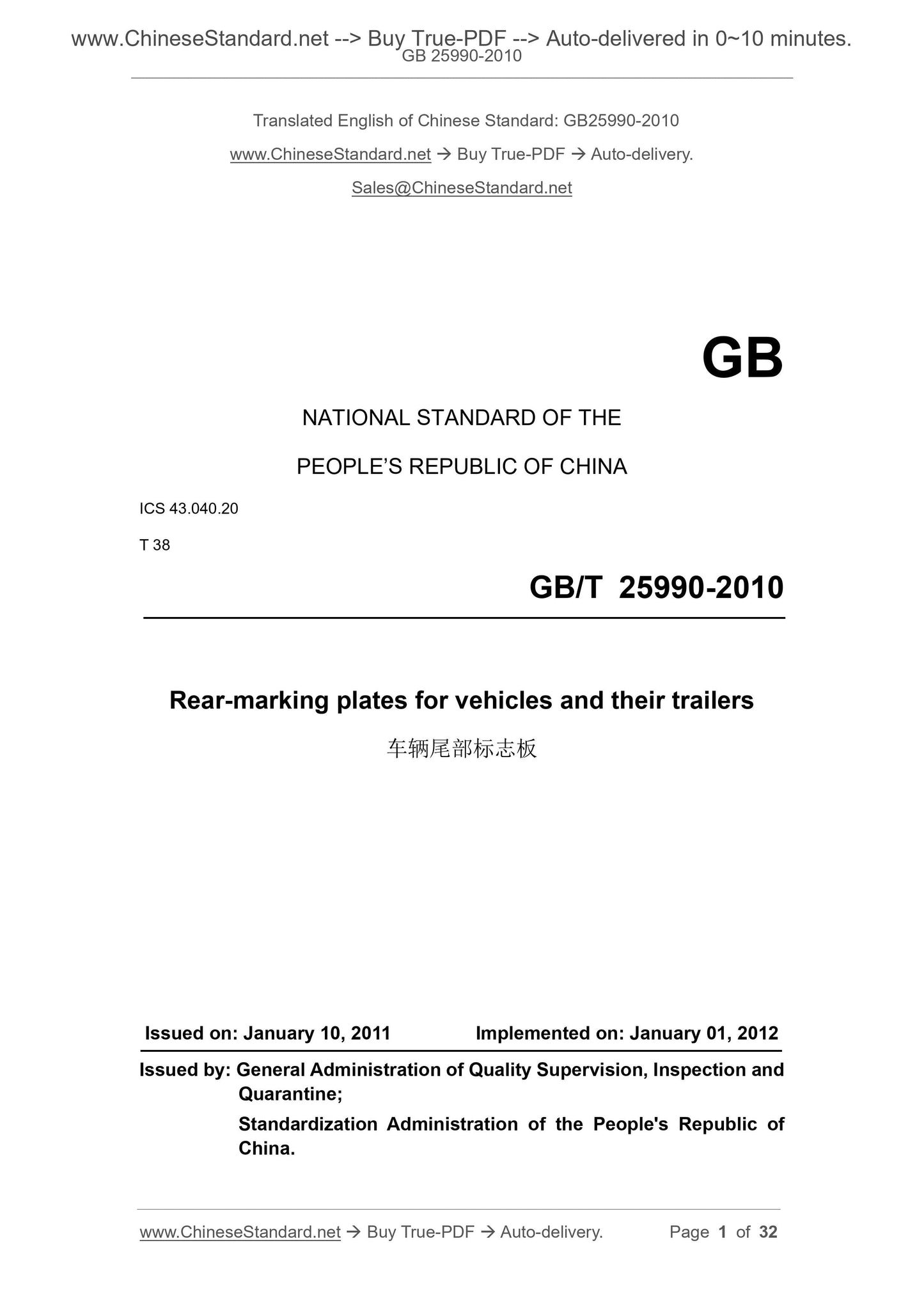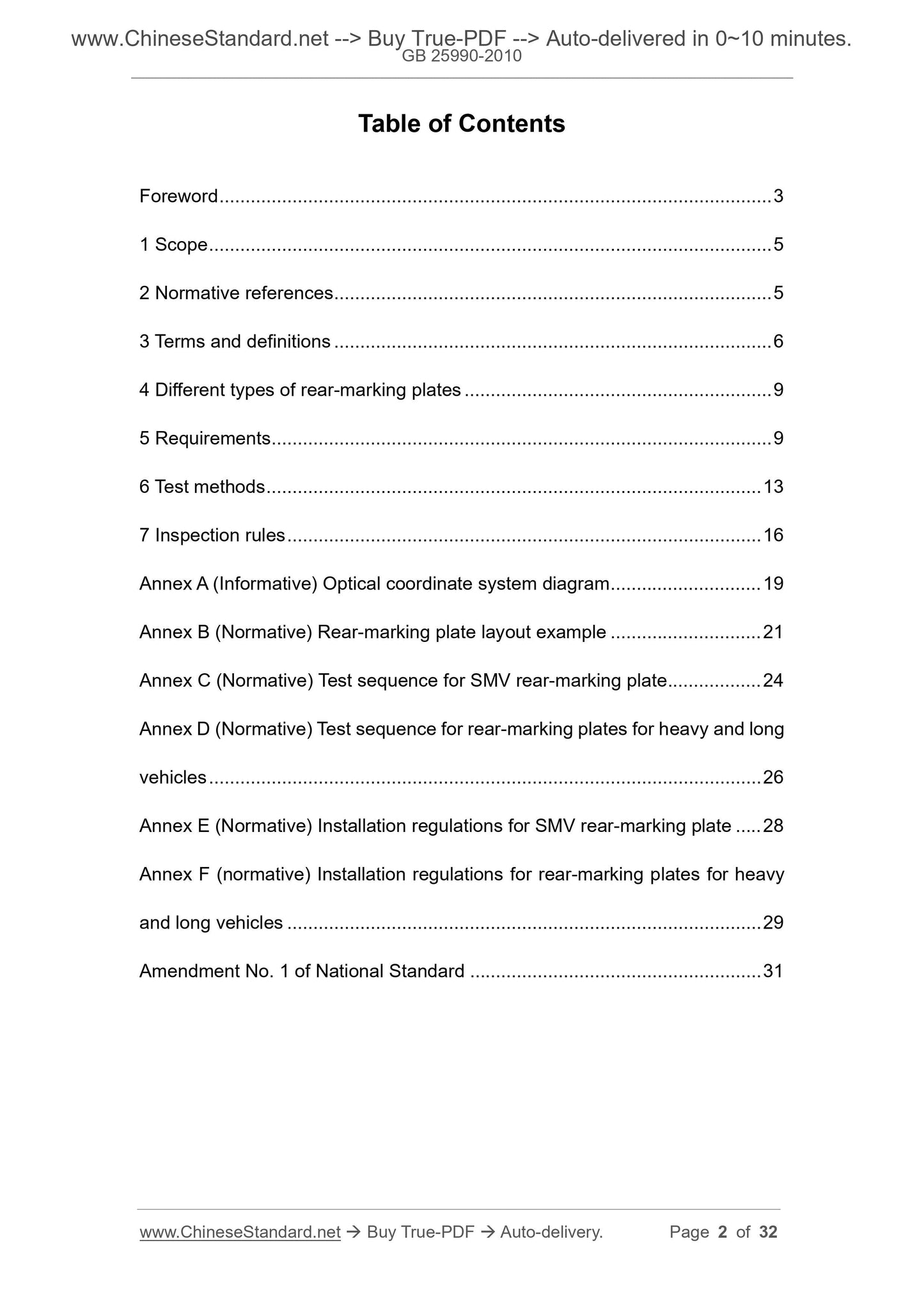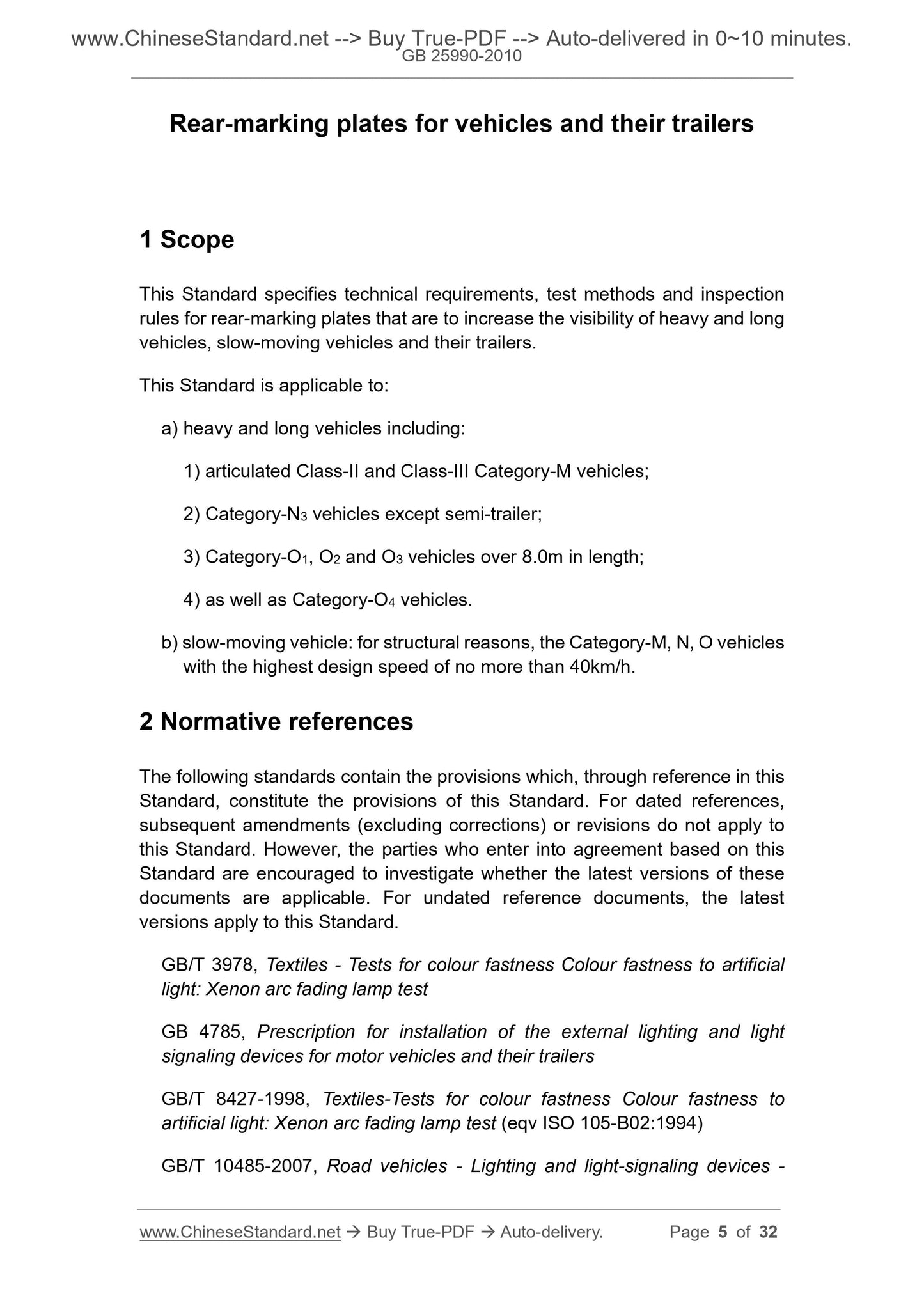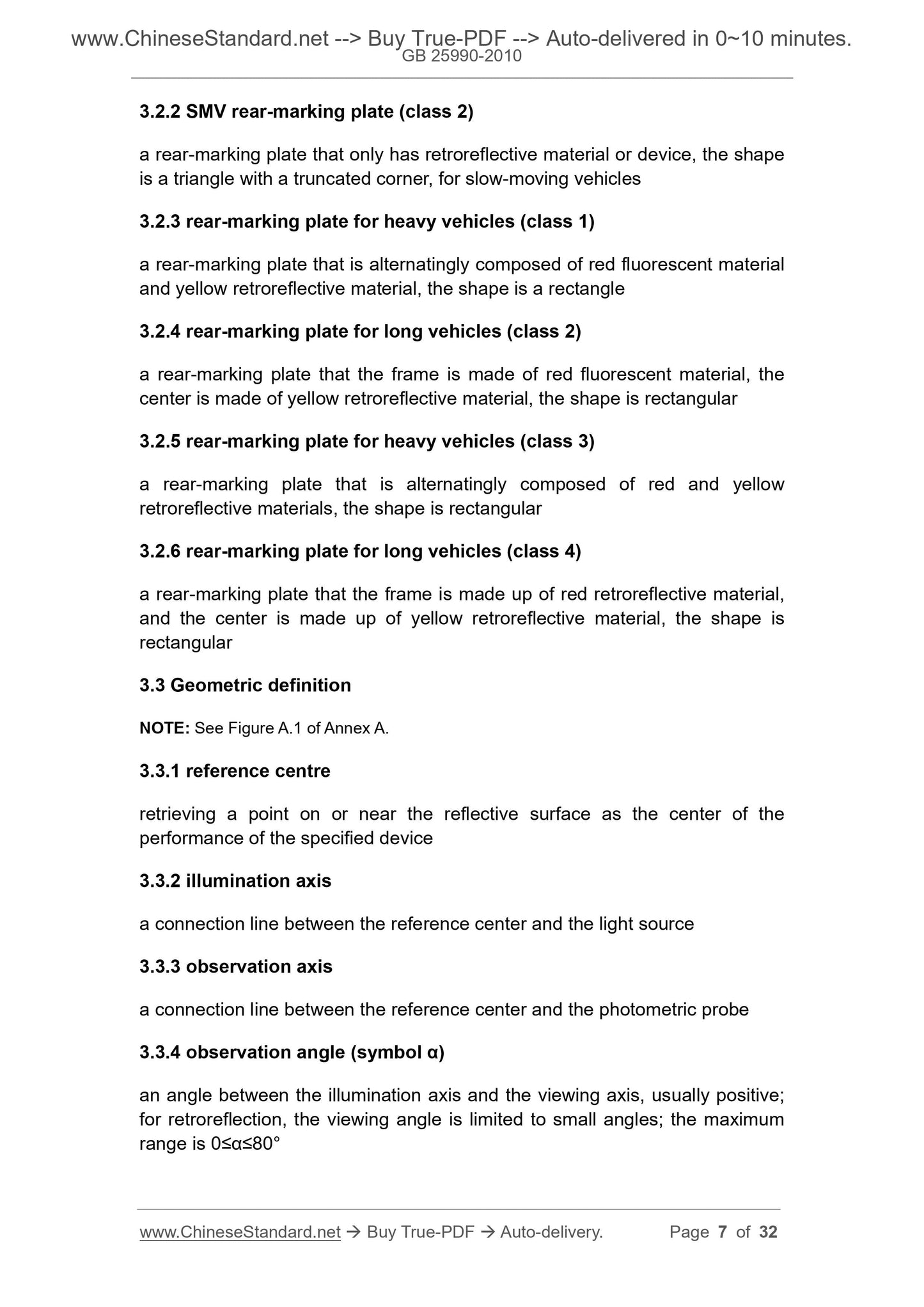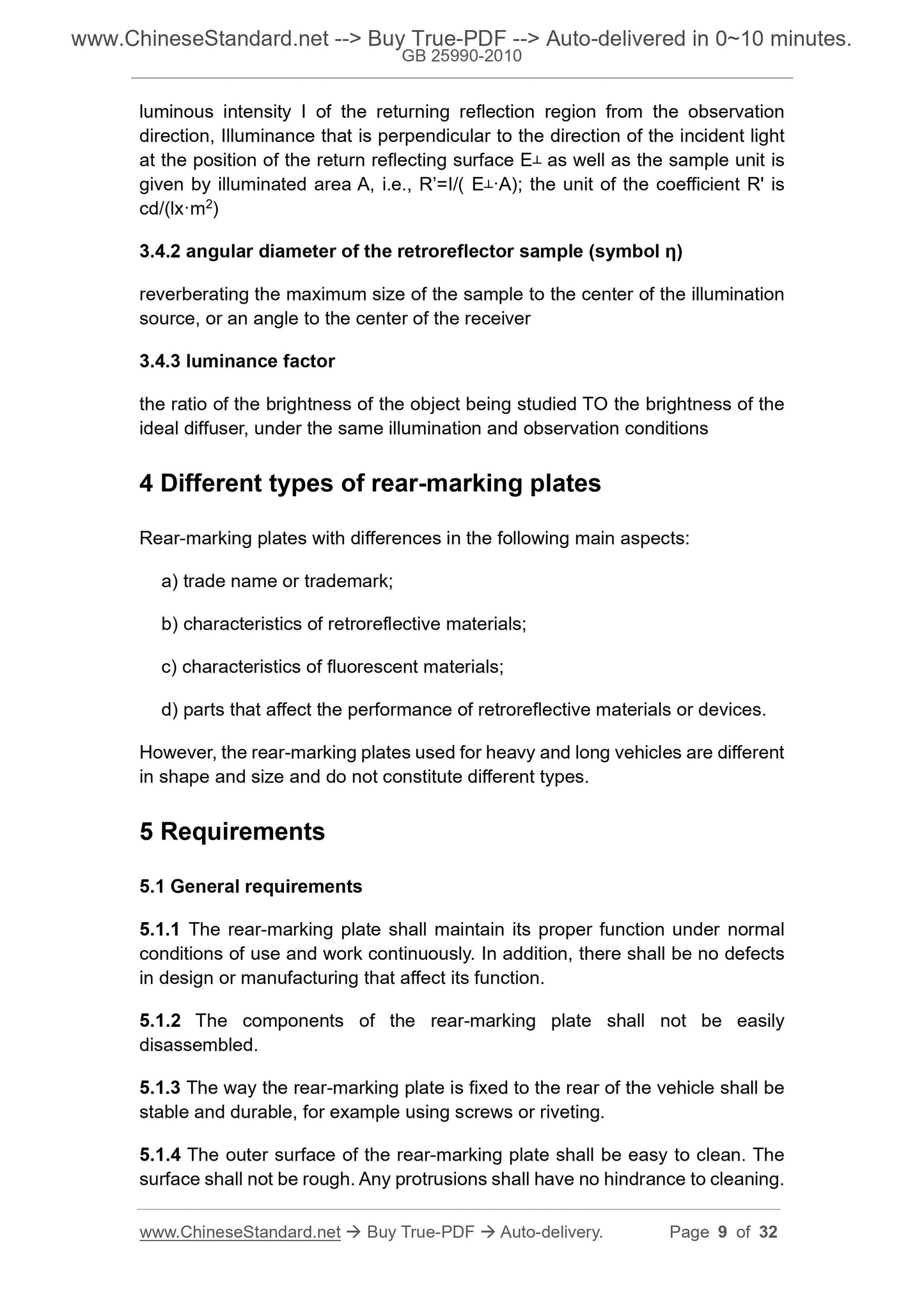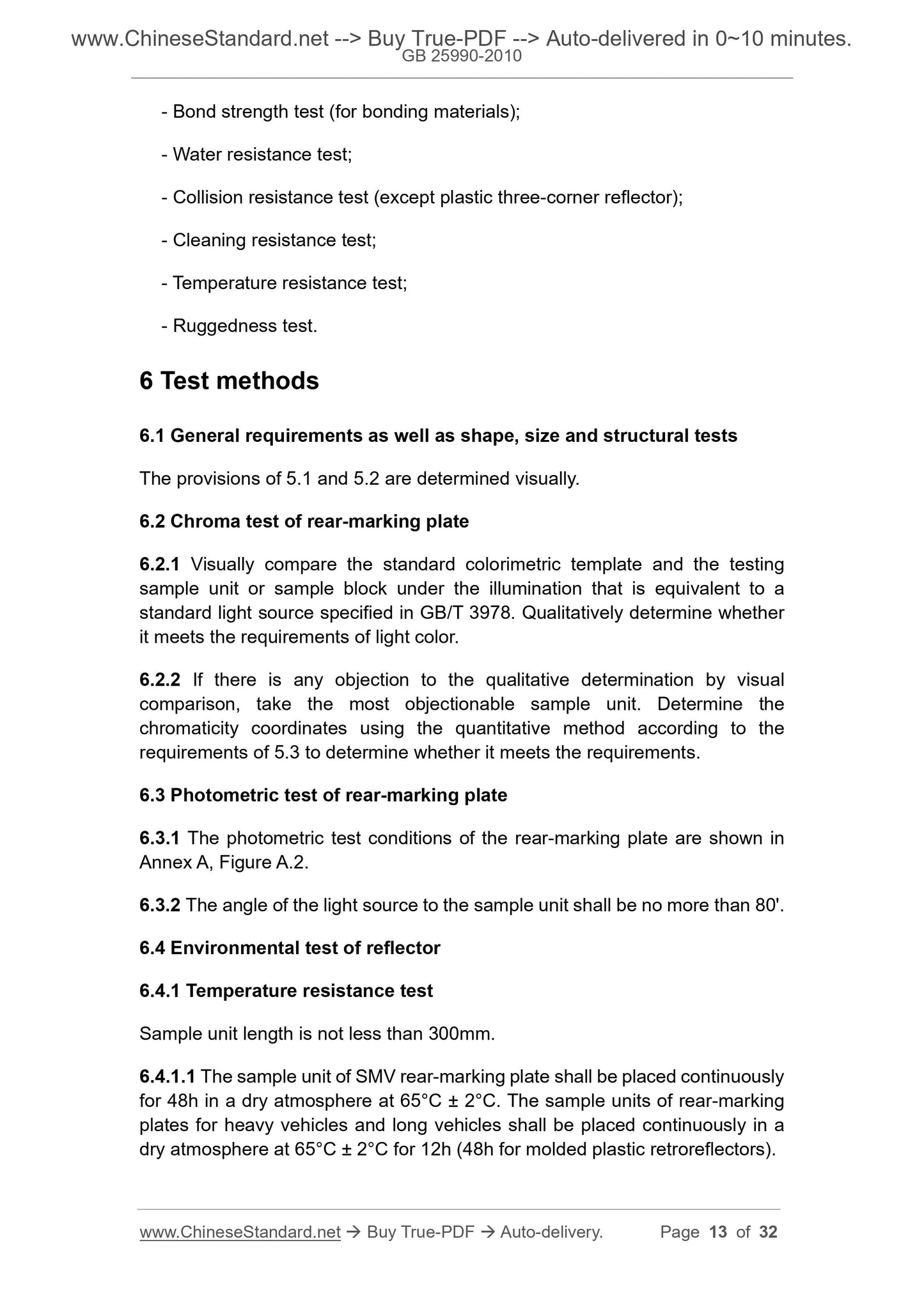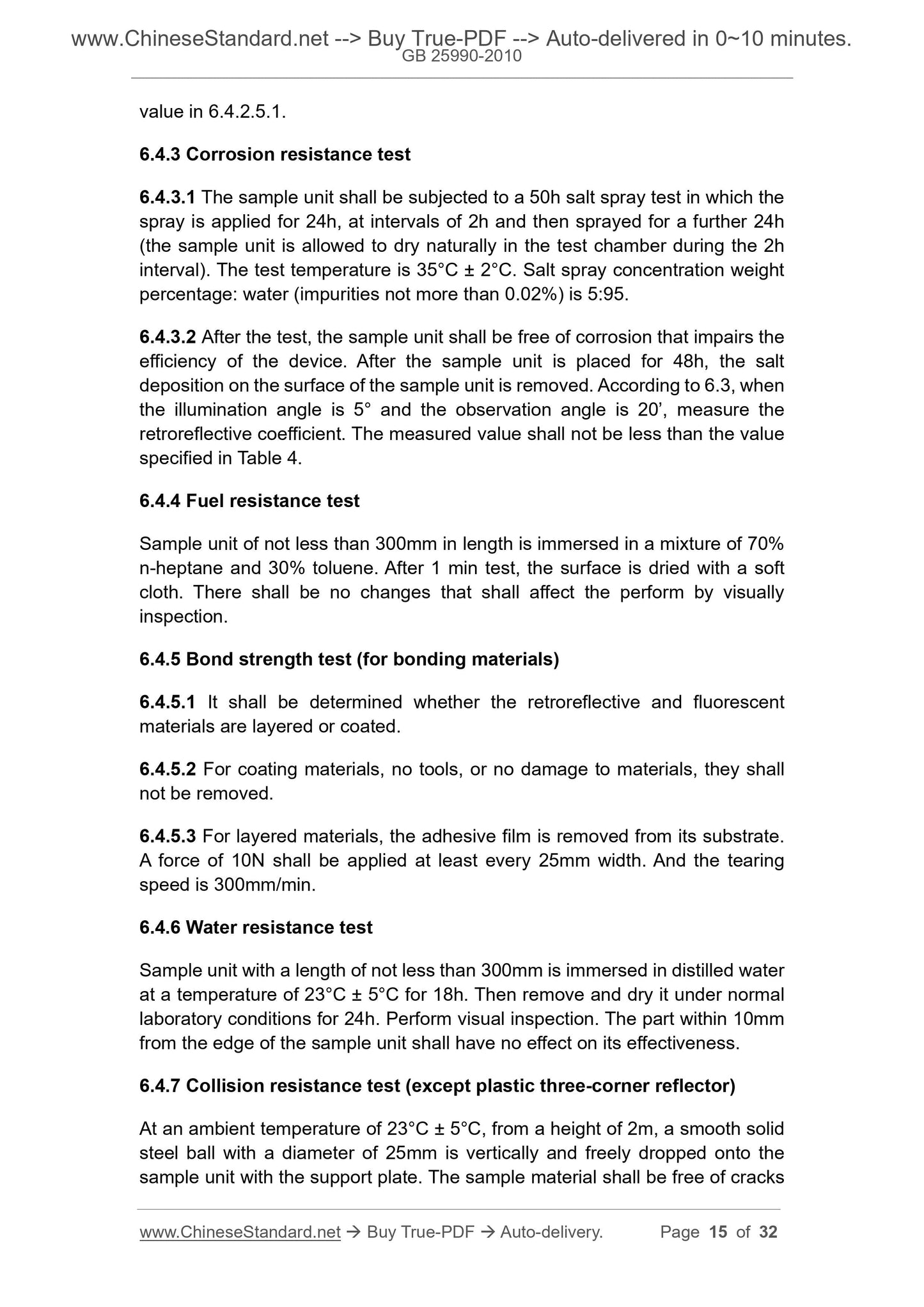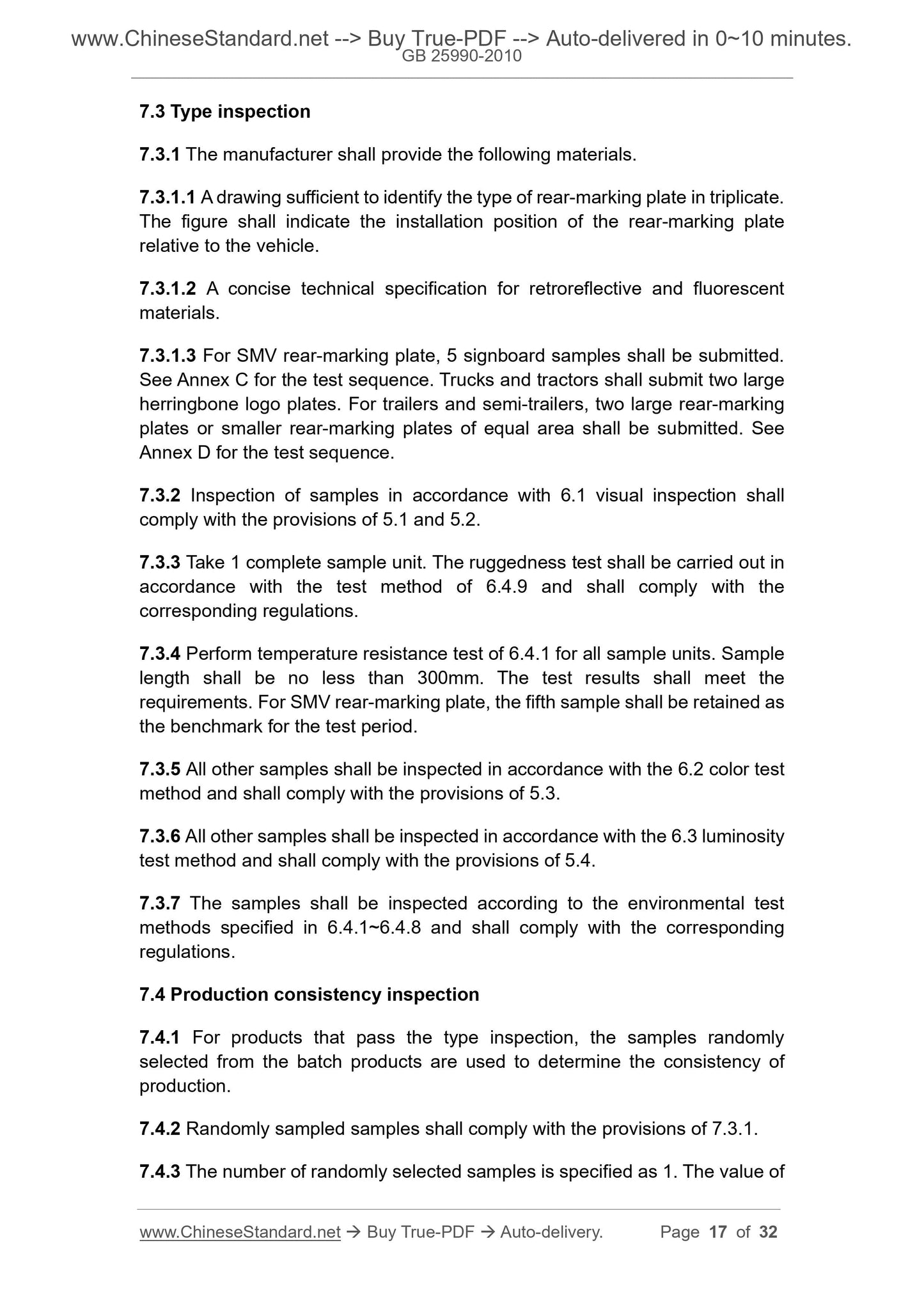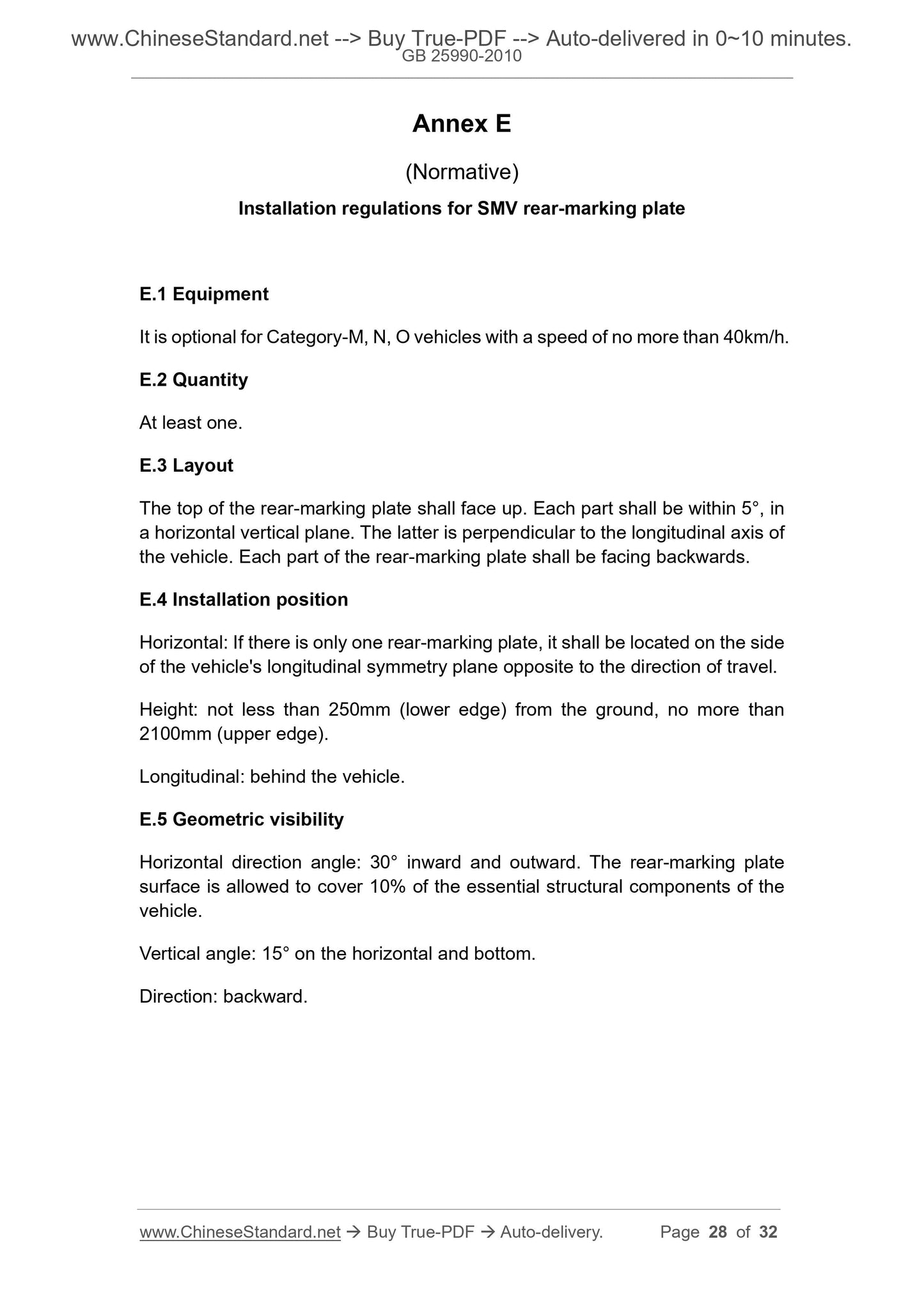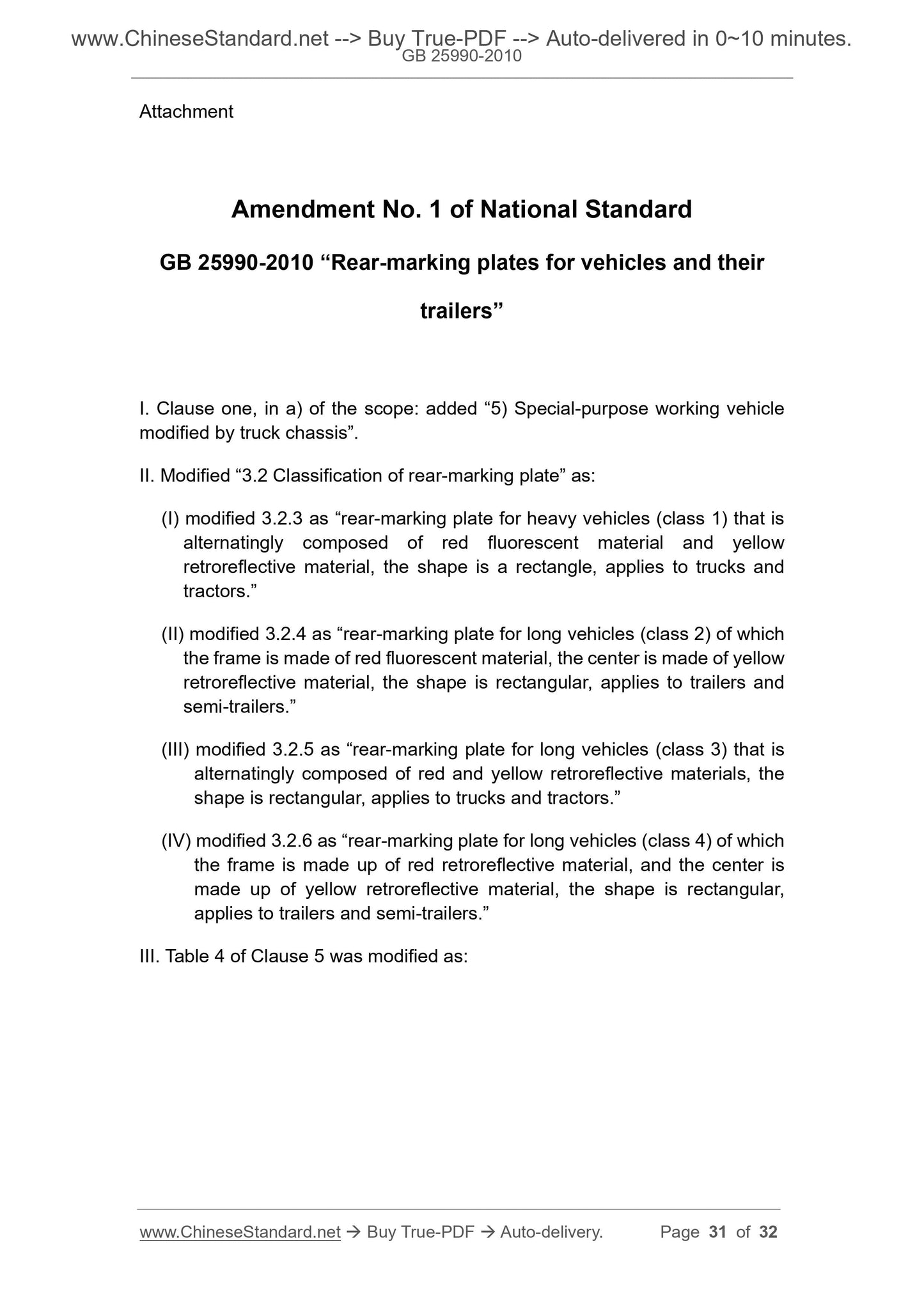1
/
of
10
www.ChineseStandard.us -- Field Test Asia Pte. Ltd.
GB 25990-2010 English PDF
GB 25990-2010 English PDF
Regular price
$115.00
Regular price
Sale price
$115.00
Unit price
/
per
Shipping calculated at checkout.
Couldn't load pickup availability
GB 25990-2010: Rear-marking plates for vehicles and their trailers [including MODIFICATION 1 2015-XG]
Delivery: 9 seconds. Download (& Email) true-PDF + Invoice.
Get Quotation: Click GB 25990-2010 (Self-service in 1-minute)
Historical versions (Master-website): GB 25990-2010
Preview True-PDF (Reload/Scroll-down if blank)
GB 25990-2010
GB
NATIONAL STANDARD OF THE
PEOPLE’S REPUBLIC OF CHINA
ICS 43.040.20
T 38
GB/T 25990-2010
Rear-marking plates for vehicles and their trailers
ISSUED ON. JANUARY 10, 2011
IMPLEMENTED ON. JANUARY 01, 2012
Issued by. General Administration of Quality Supervision, Inspection and
Quarantine;
Standardization Administration of the People's Republic of
China.
Table of Contents
Foreword ... 3
1 Scope ... 5
2 Normative references ... 5
3 Terms and definitions ... 6
4 Different types of rear-marking plates ... 9
5 Requirements ... 9
6 Test methods ... 13
7 Inspection rules ... 16
Annex A (Informative) Optical coordinate system diagram ... 19
Annex B (Normative) Rear-marking plate layout example ... 21
Annex C (Normative) Test sequence for SMV rear-marking plate ... 24
Annex D (Normative) Test sequence for rear-marking plates for heavy and long
vehicles ... 26
Annex E (Normative) Installation regulations for SMV rear-marking plate ... 28
Annex F (normative) Installation regulations for rear-marking plates for heavy
and long vehicles ... 29
Amendment No. 1 of National Standard ... 31
Rear-marking plates for vehicles and their trailers
1 Scope
This Standard specifies technical requirements, test methods and inspection
rules for rear-marking plates that are to increase the visibility of heavy and long
vehicles, slow-moving vehicles and their trailers.
This Standard is applicable to.
a) heavy and long vehicles including.
1) articulated Class-II and Class-III Category-M vehicles;
2) Category-N3 vehicles except semi-trailer;
3) Category-O1, O2 and O3 vehicles over 8.0m in length;
4) as well as Category-O4 vehicles.
b) slow-moving vehicle. for structural reasons, the Category-M, N, O vehicles
with the highest design speed of no more than 40km/h.
2 Normative references
The following standards contain the provisions which, through reference in this
Standard, constitute the provisions of this Standard. For dated references,
subsequent amendments (excluding corrections) or revisions do not apply to
this Standard. However, the parties who enter into agreement based on this
Standard are encouraged to investigate whether the latest versions of these
documents are applicable. For undated reference documents, the latest
versions apply to this Standard.
GB/T 3978, Textiles - Tests for colour fastness Colour fastness to artificial
light. Xenon arc fading lamp test
GB 4785, Prescription for installation of the external lighting and light
signaling devices for motor vehicles and their trailers
GB/T 8427-1998, Textiles-Tests for colour fastness Colour fastness to
artificial light. Xenon arc fading lamp test (eqv ISO 105-B02.1994)
GB/T 10485-2007, Road vehicles - Lighting and light-signaling devices -
3.2.2 SMV rear-marking plate (class 2)
a rear-marking plate that only has retroreflective material or device, the shape
is a triangle with a truncated corner, for slow-moving vehicles
3.2.3 rear-marking plate for heavy vehicles (class 1)
a rear-marking plate that is alternatingly composed of red fluorescent material
and yellow retroreflective material, the shape is a rectangle
3.2.4 rear-marking plate for long vehicles (class 2)
a rear-marking plate that the frame is made of red fluorescent material, the
center is made of yellow retroreflective material, the shape is rectangular
3.2.5 rear-marking plate for heavy vehicles (class 3)
a rear-marking plate that is alternatingly composed of red and yellow
retroreflective materials, the shape is rectangular
3.2.6 rear-marking plate for long vehicles (class 4)
a rear-marking plate that the frame is made up of red retroreflective material,
and the center is made up of yellow retroreflective material, the shape is
rectangular
3.3 Geometric definition
NOTE. See Figure A.1 of Annex A.
3.3.1 reference centre
retrieving a point on or near the reflective surface as the center of the
performance of the specified device
3.3.2 illumination axis
a connection line between the reference center and the light source
3.3.3 observation axis
a connection line between the reference center and the photometric probe
3.3.4 observation angle (symbol α)
an angle between the illumination axis and the viewing axis, usually positive;
for retroreflection, the viewing angle is limited to small angles; the maximum
range is 0≤α≤80°
luminous intensity I of the returning reflection region from the observation
direction, Illuminance that is perpendicular to the direction of the incident light
at the position of the return reflecting surface E┴ as well as the sample unit is
given by illuminated area A, i.e., R’=I/( E┴·A); the unit of the coefficient R' is
cd/(lx·m2)
3.4.2 angular diameter of the retroreflector sample (symbol η)
reverberating the maximum size of the sample to the center of the illumination
source, or an angle to the center of the receiver
3.4.3 luminance factor
the ratio of the brightness of the object being studied TO the brightness of the
ideal diffuser, under the same illumination and observation conditions
4 Different types of rear-marking plates
Rear-marking plates with differences in the following main aspects.
a) trade name or trademark;
b) characteristics of retroreflective materials;
c) characteristics of fluorescent materials;
d) parts that affect the performance of retroreflective materials or devices.
However, the rear-marking plates used for heavy and long vehicles are different
in shape and size and do not constitute different types.
5 Requirements
5.1 General requirements
5.1.1 The rear-marking plate shall maintain its proper function under normal
conditions of use and work continuously. In addition, there shall be no defects
in design or manufacturing that affect its function.
5.1.2 The components of the rear-marking plate shall not be easily
disassembled.
5.1.3 The way the rear-marking plate is fixed to the rear of the vehicle shall be
stable and durable, for example using screws or riveting.
5.1.4 The outer surface of the rear-marking plate shall be easy to clean. The
surface shall not be rough. Any protrusions shall have no hindrance to cleaning.
- Bond strength test (for bonding materials);
- Water resistance test;
- Collision resistance test (except plastic three-corner reflector);
- Cleaning resistance test;
- Temperature resistance test;
- Ruggedness test.
6 Test methods
6.1 General requirements as well as shape, size and structural tests
The provisions of 5.1 and 5.2 are determined visually.
6.2 Chroma test of rear-marking plate
6.2.1 Visually compare the standard colorimetric template and the testing
sample unit or sample block under the illumination that is equivalent to a
standard light source specified in GB/T 3978. Qualitatively determine whether
it meets the requirements of light color.
6.2.2 If there is any objection to the qualitative determination by visual
comparison, take the most objectionable sample unit. Determine the
chromaticity coordinates using the quantitative method according to the
requirements of 5.3 to determine whether it meets the requirements.
6.3 Photometric test of rear-marking plate
6.3.1 The photometric test conditions of the rear-marking plate are shown in
Annex A, Figure A.2.
6.3.2 The angle of the light source to the sample unit shall be no more than 80'.
6.4 Environmental test of reflector
6.4.1 Temperature resistance test
Sample unit length is not less than 300mm.
6.4.1.1 The sample unit of SMV rear-marking plate shall be placed continuously
for 48h in a dry atmosphere at 65°C ± 2°C. The sample units of rear-marking
plates for heavy vehicles and long vehicles shall be placed continuously in a
dry atmosphere at 65°C ± 2°C for 12h (48h for molded plastic retroreflectors).
value in 6.4.2.5.1.
6.4.3 Corrosion resistance test
6.4.3.1 The sample unit shall be subjected to a 50h salt spray test in which the
spray is applied for 24h, at intervals of 2h and then sprayed for a further 24h
(the sample unit is allowed to dry naturally in the test chamber during the 2h
interval). The test temperature is 35°C ± 2°C. Salt spray concentration weight
percentage. water (impurities not more than 0.02%) is 5.95.
6.4.3.2 After the test, the sample unit shall be free of corrosion that impairs the
efficiency of the device. After the sample unit is placed for 48h, the salt
deposition on the surface of the sample unit is removed. According to 6.3, when
the illumination angle is 5° and the observation angle is 20’, measure the
retroreflective coefficient. The measured value shall not be less than the value
specified in Table 4.
6.4.4 Fuel resistance test
Sample unit of not less than 300mm in length is immersed in a mixture of 70%
n-heptane and 30% toluene. After 1 min test, the surface is dried with a soft
cloth. There shall be no changes that shall affect the perform by visually
inspection.
6.4.5 Bond strength test (for bonding materials)
6.4.5.1 It shall be determined whether the retroreflective and fluorescent
materials are layered or coated.
6.4.5.2 For coating materials, no tools, or no damage to materials, they shall
not be removed.
6.4.5.3 For layered materials, the adhesive film is removed from its substrate.
A force of 10N shall be applied at least every 25mm width. And the tearing
speed is 300mm/min.
6.4.6 Water resistance test
Sample unit with a length of not less than 300mm is immersed in distilled water
at a temperature of 23°C ± 5°C for 18h. Then remove and dry it under normal
laboratory conditions for 24h. Perform visual inspection. The part within 10mm
from the edge of the sample unit shall have no effect on its effectiveness.
6.4.7 Collision resistance test (except plastic three-corner reflector)
At an ambient temperature of 23°C ± 5°C, from a height of 2m, a smooth solid
steel ball with a diameter of 25mm is vertically and freely dropped onto the
sample unit with the support plate. The sample material shall be free of cracks
7.3 Type inspection
7.3.1 The manufacturer shall provide the following materials.
7.3.1.1 A drawing sufficient to identify the type of rear-marking plate in triplicate.
The figure shall indicate the installation position of the rear-marking plate
relative to the vehicle.
7.3.1.2 A concise technical specification for retroreflective and fluorescent
materials.
7.3.1.3 For SMV rear-marking plate, 5 signboard samples shall be submitted.
See Annex C for the test sequence. Trucks and tractors shall submit two large
herringbone logo plates. For trailers and semi-trailers, two large rear-marking
plates or smaller rear-marking plates of equal area shall be submitted. See
Annex D for the test sequence.
7.3.2 Inspection of samples in accordance with 6.1 visual inspection shall
comply with the provisions of 5.1 and 5.2.
7.3.3 Take 1 complete sample unit. The ruggedness test shall be carried out in
accordance with the test method of 6.4.9 and shall comply with the
corresponding regulations.
7.3.4 Perform temperature resistance test of 6.4.1 for all sample units. Sample
length shall be no less than 300mm. The test results shall meet the
requirements. For SMV rear-marking plate, the fifth sample shall be retained as
the benchmark for the test period.
7.3.5 All other samples shall be inspected in accordance with the 6.2 color test
method and shall comply with the provisions of 5.3.
7.3.6 All other samples shall be inspected in accordance with the 6.3 luminosity
test method and shall comply with the provisions of 5.4.
7.3.7 The samples shall be inspected according to the environmental test
methods specified in 6.4.1~6.4.8 and shall comply with the corresponding
regulations.
7.4 Production consistency inspection
7.4.1 For products that pass the type inspection, the samples randomly
selected from the batch products are used to determine the consistency of
production.
7.4.2 Randomly sampled samples shall comply with the provisions of 7.3.1.
7.4.3 The number of randomly selected samples is specified as 1. The value of
Annex E
(Normative)
Installation regulations for SMV rear-marking plate
E.1 Equipment
It is optional for Category-M, N, O vehicles with a speed of no more than 40km/h.
E.2 Quantity
At least one.
E.3 Layout
The top of the rear-marking plate shall face up. Each part shall be within 5°, in
a horizontal vertical plane. The latter is perpendicular to the longitudinal axis of
the vehicle. Each part of the rear-marking plate shall be facing backwards.
E.4 Installation position
Horizontal. If there is only one rear-marking plate, it shall be located on the side
of the vehicle's longitudinal symmetry plane opposite to the direction of travel.
Height. not less than 250mm (lower edge) from the ground, no more than
2100mm (upper edge).
Longitudinal. behind the vehicle.
E.5 Geometric visibility
Horizontal direction angle. 30° inward and outward. The rear-marking plate
surface is allowed to cover 10% of the essential structural components of the
vehicle.
Vertical angle. 15° on the horizontal and bottom.
Direction. backward.
Attachment
Amendment No. 1 of National Standard
GB 25990-2010 “Rear-marking plates for vehicles and their
trailers”
I. Clause one, in a) of the scope. added “5) Special-purpose working vehicle
modified by truck chassis”.
II. Modified “3.2 Classification of rear-marking plate” as.
(I) modified 3.2.3 as “rear-marking plate for heavy vehicles (class 1) that is
alternatingly composed of red fluorescent material and yellow
retroreflective material, the shape is a rectangle, applies to trucks and
tractors.”
(II) modified 3.2.4 as “rear-marking plate for long vehicles (class 2) of which
the frame is made of red fluorescent material, the center is made of yellow
retroreflective material, the shape is rectangular, applies to trailers and
semi-trailers.”
(III) modified 3.2.5 as “rear-...
Delivery: 9 seconds. Download (& Email) true-PDF + Invoice.
Get Quotation: Click GB 25990-2010 (Self-service in 1-minute)
Historical versions (Master-website): GB 25990-2010
Preview True-PDF (Reload/Scroll-down if blank)
GB 25990-2010
GB
NATIONAL STANDARD OF THE
PEOPLE’S REPUBLIC OF CHINA
ICS 43.040.20
T 38
GB/T 25990-2010
Rear-marking plates for vehicles and their trailers
ISSUED ON. JANUARY 10, 2011
IMPLEMENTED ON. JANUARY 01, 2012
Issued by. General Administration of Quality Supervision, Inspection and
Quarantine;
Standardization Administration of the People's Republic of
China.
Table of Contents
Foreword ... 3
1 Scope ... 5
2 Normative references ... 5
3 Terms and definitions ... 6
4 Different types of rear-marking plates ... 9
5 Requirements ... 9
6 Test methods ... 13
7 Inspection rules ... 16
Annex A (Informative) Optical coordinate system diagram ... 19
Annex B (Normative) Rear-marking plate layout example ... 21
Annex C (Normative) Test sequence for SMV rear-marking plate ... 24
Annex D (Normative) Test sequence for rear-marking plates for heavy and long
vehicles ... 26
Annex E (Normative) Installation regulations for SMV rear-marking plate ... 28
Annex F (normative) Installation regulations for rear-marking plates for heavy
and long vehicles ... 29
Amendment No. 1 of National Standard ... 31
Rear-marking plates for vehicles and their trailers
1 Scope
This Standard specifies technical requirements, test methods and inspection
rules for rear-marking plates that are to increase the visibility of heavy and long
vehicles, slow-moving vehicles and their trailers.
This Standard is applicable to.
a) heavy and long vehicles including.
1) articulated Class-II and Class-III Category-M vehicles;
2) Category-N3 vehicles except semi-trailer;
3) Category-O1, O2 and O3 vehicles over 8.0m in length;
4) as well as Category-O4 vehicles.
b) slow-moving vehicle. for structural reasons, the Category-M, N, O vehicles
with the highest design speed of no more than 40km/h.
2 Normative references
The following standards contain the provisions which, through reference in this
Standard, constitute the provisions of this Standard. For dated references,
subsequent amendments (excluding corrections) or revisions do not apply to
this Standard. However, the parties who enter into agreement based on this
Standard are encouraged to investigate whether the latest versions of these
documents are applicable. For undated reference documents, the latest
versions apply to this Standard.
GB/T 3978, Textiles - Tests for colour fastness Colour fastness to artificial
light. Xenon arc fading lamp test
GB 4785, Prescription for installation of the external lighting and light
signaling devices for motor vehicles and their trailers
GB/T 8427-1998, Textiles-Tests for colour fastness Colour fastness to
artificial light. Xenon arc fading lamp test (eqv ISO 105-B02.1994)
GB/T 10485-2007, Road vehicles - Lighting and light-signaling devices -
3.2.2 SMV rear-marking plate (class 2)
a rear-marking plate that only has retroreflective material or device, the shape
is a triangle with a truncated corner, for slow-moving vehicles
3.2.3 rear-marking plate for heavy vehicles (class 1)
a rear-marking plate that is alternatingly composed of red fluorescent material
and yellow retroreflective material, the shape is a rectangle
3.2.4 rear-marking plate for long vehicles (class 2)
a rear-marking plate that the frame is made of red fluorescent material, the
center is made of yellow retroreflective material, the shape is rectangular
3.2.5 rear-marking plate for heavy vehicles (class 3)
a rear-marking plate that is alternatingly composed of red and yellow
retroreflective materials, the shape is rectangular
3.2.6 rear-marking plate for long vehicles (class 4)
a rear-marking plate that the frame is made up of red retroreflective material,
and the center is made up of yellow retroreflective material, the shape is
rectangular
3.3 Geometric definition
NOTE. See Figure A.1 of Annex A.
3.3.1 reference centre
retrieving a point on or near the reflective surface as the center of the
performance of the specified device
3.3.2 illumination axis
a connection line between the reference center and the light source
3.3.3 observation axis
a connection line between the reference center and the photometric probe
3.3.4 observation angle (symbol α)
an angle between the illumination axis and the viewing axis, usually positive;
for retroreflection, the viewing angle is limited to small angles; the maximum
range is 0≤α≤80°
luminous intensity I of the returning reflection region from the observation
direction, Illuminance that is perpendicular to the direction of the incident light
at the position of the return reflecting surface E┴ as well as the sample unit is
given by illuminated area A, i.e., R’=I/( E┴·A); the unit of the coefficient R' is
cd/(lx·m2)
3.4.2 angular diameter of the retroreflector sample (symbol η)
reverberating the maximum size of the sample to the center of the illumination
source, or an angle to the center of the receiver
3.4.3 luminance factor
the ratio of the brightness of the object being studied TO the brightness of the
ideal diffuser, under the same illumination and observation conditions
4 Different types of rear-marking plates
Rear-marking plates with differences in the following main aspects.
a) trade name or trademark;
b) characteristics of retroreflective materials;
c) characteristics of fluorescent materials;
d) parts that affect the performance of retroreflective materials or devices.
However, the rear-marking plates used for heavy and long vehicles are different
in shape and size and do not constitute different types.
5 Requirements
5.1 General requirements
5.1.1 The rear-marking plate shall maintain its proper function under normal
conditions of use and work continuously. In addition, there shall be no defects
in design or manufacturing that affect its function.
5.1.2 The components of the rear-marking plate shall not be easily
disassembled.
5.1.3 The way the rear-marking plate is fixed to the rear of the vehicle shall be
stable and durable, for example using screws or riveting.
5.1.4 The outer surface of the rear-marking plate shall be easy to clean. The
surface shall not be rough. Any protrusions shall have no hindrance to cleaning.
- Bond strength test (for bonding materials);
- Water resistance test;
- Collision resistance test (except plastic three-corner reflector);
- Cleaning resistance test;
- Temperature resistance test;
- Ruggedness test.
6 Test methods
6.1 General requirements as well as shape, size and structural tests
The provisions of 5.1 and 5.2 are determined visually.
6.2 Chroma test of rear-marking plate
6.2.1 Visually compare the standard colorimetric template and the testing
sample unit or sample block under the illumination that is equivalent to a
standard light source specified in GB/T 3978. Qualitatively determine whether
it meets the requirements of light color.
6.2.2 If there is any objection to the qualitative determination by visual
comparison, take the most objectionable sample unit. Determine the
chromaticity coordinates using the quantitative method according to the
requirements of 5.3 to determine whether it meets the requirements.
6.3 Photometric test of rear-marking plate
6.3.1 The photometric test conditions of the rear-marking plate are shown in
Annex A, Figure A.2.
6.3.2 The angle of the light source to the sample unit shall be no more than 80'.
6.4 Environmental test of reflector
6.4.1 Temperature resistance test
Sample unit length is not less than 300mm.
6.4.1.1 The sample unit of SMV rear-marking plate shall be placed continuously
for 48h in a dry atmosphere at 65°C ± 2°C. The sample units of rear-marking
plates for heavy vehicles and long vehicles shall be placed continuously in a
dry atmosphere at 65°C ± 2°C for 12h (48h for molded plastic retroreflectors).
value in 6.4.2.5.1.
6.4.3 Corrosion resistance test
6.4.3.1 The sample unit shall be subjected to a 50h salt spray test in which the
spray is applied for 24h, at intervals of 2h and then sprayed for a further 24h
(the sample unit is allowed to dry naturally in the test chamber during the 2h
interval). The test temperature is 35°C ± 2°C. Salt spray concentration weight
percentage. water (impurities not more than 0.02%) is 5.95.
6.4.3.2 After the test, the sample unit shall be free of corrosion that impairs the
efficiency of the device. After the sample unit is placed for 48h, the salt
deposition on the surface of the sample unit is removed. According to 6.3, when
the illumination angle is 5° and the observation angle is 20’, measure the
retroreflective coefficient. The measured value shall not be less than the value
specified in Table 4.
6.4.4 Fuel resistance test
Sample unit of not less than 300mm in length is immersed in a mixture of 70%
n-heptane and 30% toluene. After 1 min test, the surface is dried with a soft
cloth. There shall be no changes that shall affect the perform by visually
inspection.
6.4.5 Bond strength test (for bonding materials)
6.4.5.1 It shall be determined whether the retroreflective and fluorescent
materials are layered or coated.
6.4.5.2 For coating materials, no tools, or no damage to materials, they shall
not be removed.
6.4.5.3 For layered materials, the adhesive film is removed from its substrate.
A force of 10N shall be applied at least every 25mm width. And the tearing
speed is 300mm/min.
6.4.6 Water resistance test
Sample unit with a length of not less than 300mm is immersed in distilled water
at a temperature of 23°C ± 5°C for 18h. Then remove and dry it under normal
laboratory conditions for 24h. Perform visual inspection. The part within 10mm
from the edge of the sample unit shall have no effect on its effectiveness.
6.4.7 Collision resistance test (except plastic three-corner reflector)
At an ambient temperature of 23°C ± 5°C, from a height of 2m, a smooth solid
steel ball with a diameter of 25mm is vertically and freely dropped onto the
sample unit with the support plate. The sample material shall be free of cracks
7.3 Type inspection
7.3.1 The manufacturer shall provide the following materials.
7.3.1.1 A drawing sufficient to identify the type of rear-marking plate in triplicate.
The figure shall indicate the installation position of the rear-marking plate
relative to the vehicle.
7.3.1.2 A concise technical specification for retroreflective and fluorescent
materials.
7.3.1.3 For SMV rear-marking plate, 5 signboard samples shall be submitted.
See Annex C for the test sequence. Trucks and tractors shall submit two large
herringbone logo plates. For trailers and semi-trailers, two large rear-marking
plates or smaller rear-marking plates of equal area shall be submitted. See
Annex D for the test sequence.
7.3.2 Inspection of samples in accordance with 6.1 visual inspection shall
comply with the provisions of 5.1 and 5.2.
7.3.3 Take 1 complete sample unit. The ruggedness test shall be carried out in
accordance with the test method of 6.4.9 and shall comply with the
corresponding regulations.
7.3.4 Perform temperature resistance test of 6.4.1 for all sample units. Sample
length shall be no less than 300mm. The test results shall meet the
requirements. For SMV rear-marking plate, the fifth sample shall be retained as
the benchmark for the test period.
7.3.5 All other samples shall be inspected in accordance with the 6.2 color test
method and shall comply with the provisions of 5.3.
7.3.6 All other samples shall be inspected in accordance with the 6.3 luminosity
test method and shall comply with the provisions of 5.4.
7.3.7 The samples shall be inspected according to the environmental test
methods specified in 6.4.1~6.4.8 and shall comply with the corresponding
regulations.
7.4 Production consistency inspection
7.4.1 For products that pass the type inspection, the samples randomly
selected from the batch products are used to determine the consistency of
production.
7.4.2 Randomly sampled samples shall comply with the provisions of 7.3.1.
7.4.3 The number of randomly selected samples is specified as 1. The value of
Annex E
(Normative)
Installation regulations for SMV rear-marking plate
E.1 Equipment
It is optional for Category-M, N, O vehicles with a speed of no more than 40km/h.
E.2 Quantity
At least one.
E.3 Layout
The top of the rear-marking plate shall face up. Each part shall be within 5°, in
a horizontal vertical plane. The latter is perpendicular to the longitudinal axis of
the vehicle. Each part of the rear-marking plate shall be facing backwards.
E.4 Installation position
Horizontal. If there is only one rear-marking plate, it shall be located on the side
of the vehicle's longitudinal symmetry plane opposite to the direction of travel.
Height. not less than 250mm (lower edge) from the ground, no more than
2100mm (upper edge).
Longitudinal. behind the vehicle.
E.5 Geometric visibility
Horizontal direction angle. 30° inward and outward. The rear-marking plate
surface is allowed to cover 10% of the essential structural components of the
vehicle.
Vertical angle. 15° on the horizontal and bottom.
Direction. backward.
Attachment
Amendment No. 1 of National Standard
GB 25990-2010 “Rear-marking plates for vehicles and their
trailers”
I. Clause one, in a) of the scope. added “5) Special-purpose working vehicle
modified by truck chassis”.
II. Modified “3.2 Classification of rear-marking plate” as.
(I) modified 3.2.3 as “rear-marking plate for heavy vehicles (class 1) that is
alternatingly composed of red fluorescent material and yellow
retroreflective material, the shape is a rectangle, applies to trucks and
tractors.”
(II) modified 3.2.4 as “rear-marking plate for long vehicles (class 2) of which
the frame is made of red fluorescent material, the center is made of yellow
retroreflective material, the shape is rectangular, applies to trailers and
semi-trailers.”
(III) modified 3.2.5 as “rear-...
Share
